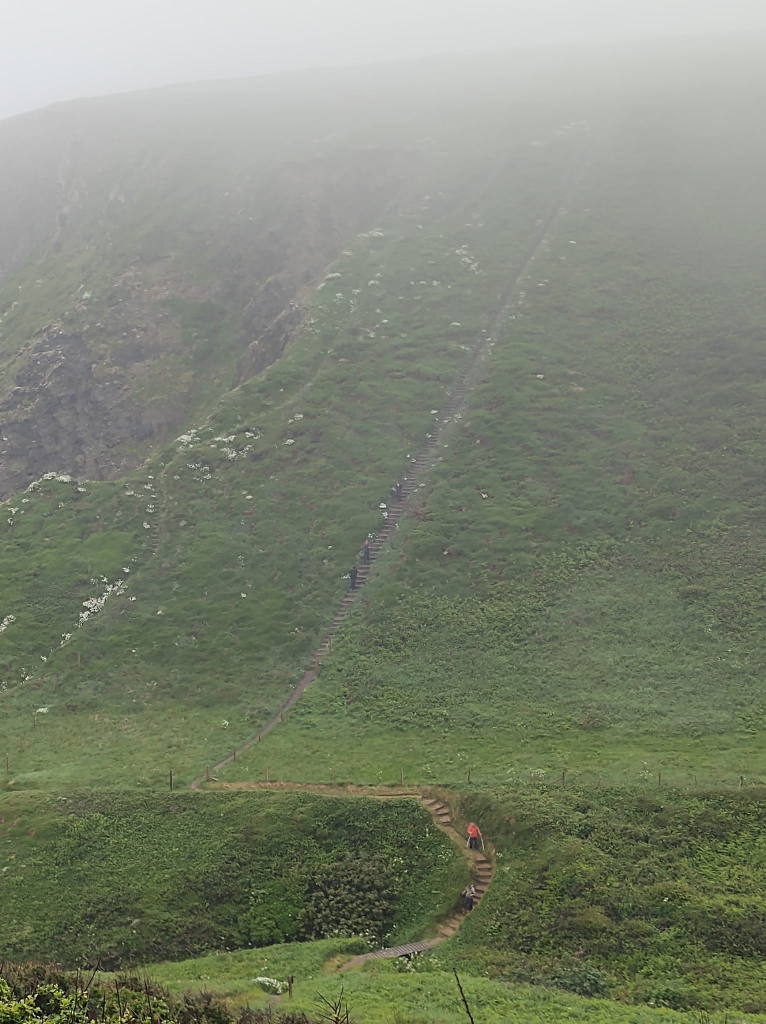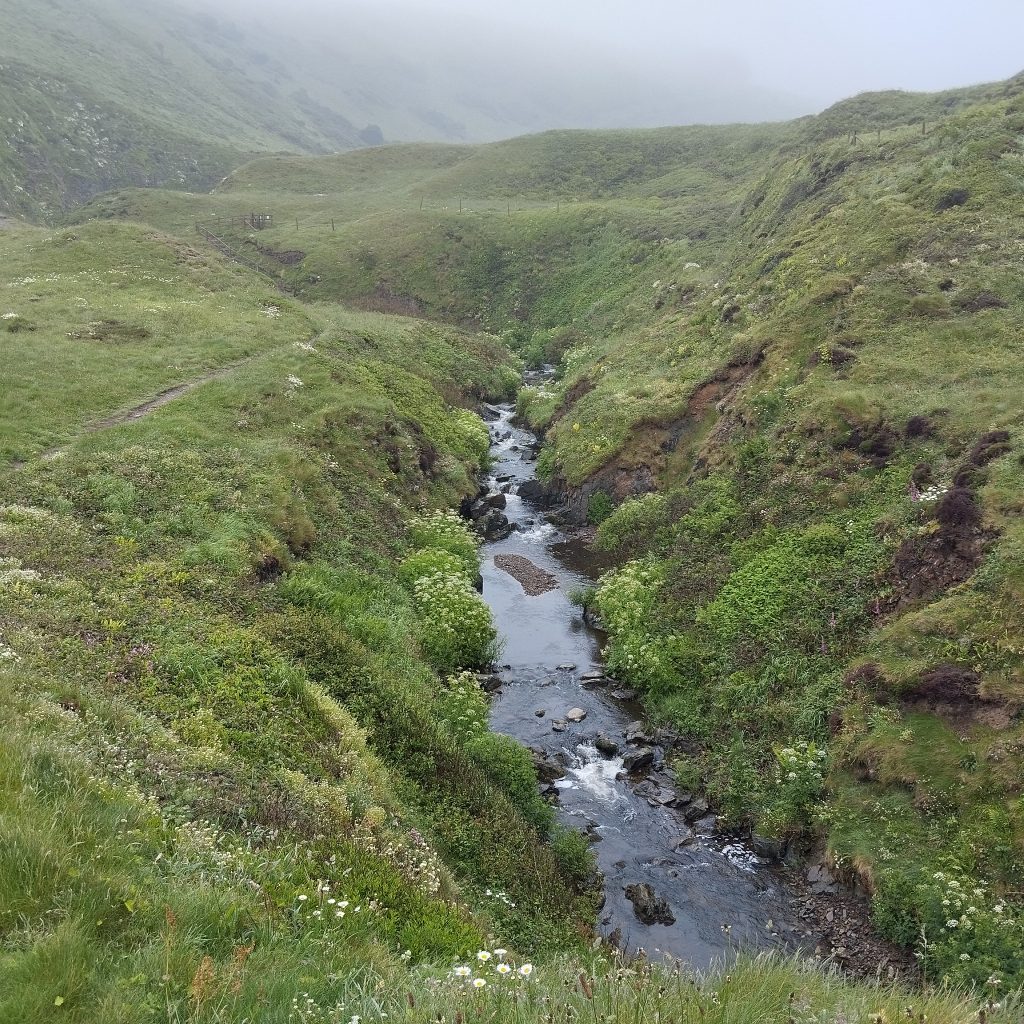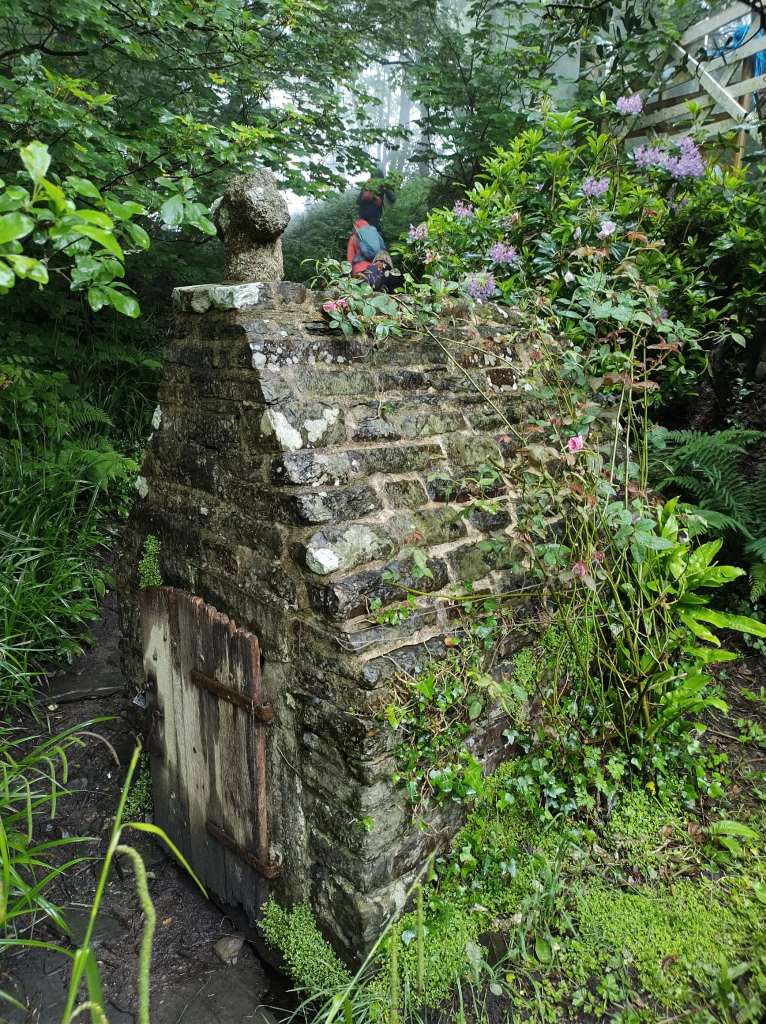Our aim to walk the TAMARA TRAIL, not in a liner fashion but loops back to our cars and including a church with bells.
We started on 28th May 2024, a wet day at Morwenstow.
The walk took us from the churchyard, down through the old vicarage, through a wooded area, over a Footbridge to a pedestrian gate where we headed left out to the coast. Turning right/north we followed this along the cliff top, edged with colourful wild flowers. The views would have been impressive if we could have seen them through the mizzle. We could just make out the way ahead across the valley and met other hikers on their coastal path challenges.

We counted as we climbed the 202 steps up and stopped for a photo at the Tamara C2C sign post, high on the cliff top.


But didn’t turn here as we dropped down to the Devon/Cornwall border, footbridge over the stream and had a lunch stop at Marsland Mouth black pebble beach.
Refreshed we decided to climb the slog up to Ronald Duncans writing hut. Where we met hikers from the Germany/Austria border, then backtracked down and headed into Marsland Valley Nature Reserve, foxgloves were impressive here and followed some of the Tamera C2C discs through the woodland path , eventually emerging at Gooseham Mill. Here we headed UP HILL on the road into Gooseham, with its lovely thatched buildings. Turned right just after Gooseham Barton, followed the road and turned left just after Glen Elm cottage onto a track … keep going… over the road…. More track….. left and quick right and you’ll soon see a FP sign on the left into a maize field. Metal gate tied with blue, pink and orange twine. Follow the hedge on your right… go through the gateway and keep the hedge on your left, down and around until you see a pedestrian gate set back in the hedge onto a grassy track. Follow to the end, another pedestrian gate go straight ahead (drainage pipes being laid when we were here). Keep hedge on your left all the way into a lane (dumping area) keep going back to the church. The Holy well is at the end of this track on the Right at the right of the entrance to the old vicarage driveway. The NT sign was hidden in high grass.

Then we headed for the TEA ROOMS by our cars, they didn’t flinch as we marched in slightly wet and muddy and the tea and cakes tasted marvellous. We’ll visit Hawkers Hut another time.
We started the walk round 12ish and finished at 5ish and covered 7 ½ miles.
More notes:
Shaun met us at St Morwenna and St John the Baptist Church and we explored the info about Rev Hawker, his 1st wife is buried by the pulpit, the stain glass windows, carved pew ends, figure head from the Caledonia ship wreck and made lots of noise on the eight bells, four cast in 1753.
Between 1824 and 1874 there were more than eighty shipwrecks recorded along this stretch of the North Cornwall Coast. The Two main shipwrecks from the Morwenstow area that are memorialised within the Church grounds, the ‘Caledonia’ and the ‘Alonzo’. The wreck of the Caledonia was the first major disaster to happen after the Reverend Hawker took up residence in Morwenstow.
In the early hours of the 8th September 1842 the 200 ton Scottish brig the ‘Caledonia of Arbroath’ ran aground off Sharpnose Point, just along the coast from Morwenstow Church. All but one of the Caledonia’s crew was lost and were laid to rest in the Morwenstow Churchyard beneath the figurehead from their ship. The figurehead of the Caledonia is a depiction of a Scottish Amazon complete with sword, shield, Tam’o shanter and sporran. She has become known locally as the ‘Last Virgin of Morwenstow’.
She marked the final resting place of the Caledonia’s crew for nearly 200 years until it was decided in 2004 that the original figurehead should be removed for conservation and would be replaced with a replica, whilst the original would be placed inside the Church, so as to be better protected from the elements.
Standing near the replica figurehead of the Caledonia is a carved granite Cornish cross marked with the words “Unknown Yet Well Known” marking the area where more sailors who lost their lives along the Morwenstow coastline were laid to rest by the Reverend Hawker. Amongst them is the Captain of the Alonzo, and many of her crew.
Robert Stephen Hawker (1803 – 1875) is credited with having written Cornwall’s anthem Trelawney’. He was born in the clergy house of Charles Church, Plymouth, 1803. Soon after his birth, his father became the curate of Stratton.
He attended Oxford University where he met his first wife, Charlotte aged 41. He was appointed Vicar for Morwenstow in 1834. In 1844, Hawker built his driftwood clifftop retreat, Hawker’s Hut and it is the smallest building maintained by the National Trust. Alfred Tennyson and Charles Kingsley visited him at his hut.
After the death of his first wife Charlotte, in 1863, Hawker married Pauline Kuczynski in 1864. Together they had three daughters. Hawker died 1875, having converted to Catholicism on his deathbed. He was buried in the Ford Park Cemetery in Plymouth with his second wife Pauline. Hawker wrote: “What a life mine would be if it were all written and published in a book.”
Toilet located outside the church, snails everywhere in the churchyard.
At the entry to the churchyard are an adjoining stile, a lychgate and a small stone building. The lychgate, which is wooden with a slate roof, was built in 1641 and extensively repaired in 1738. And the stone building which is now used as a store was at one point used as a temporary mortuary for laying out the drowned sailors from the shipwrecks along the coast. The current plans are to turn this into overnight accommodation for passing hikers.
St Johns Holy Well was mentioned in a 1296 document. It seems likely it was in use long before that time. The vicarage was home to Rev. RS Hawker. The word ‘eccentric’ must have been invented to describe Rev. Hawker, who wrote poetry in a hut made of driftwood built into the steep cliffs outside the churchyard.
Hawker was involved in a contentious court case centred on St John’s Well. It seems that in 1843 Sir John Yarde Buller claimed the well and the ground it stood on. Hawker refused to yield, and the case went to the Assizes in Bodmin, where the hearing took two whole days. The court found in the Church’s favour, and Buller was forced to pay 1370 pounds court costs, a huge amount at the time. The church still has the right to draw water from the well for baptisms.
North on the coastal path: Ronald Duncan’s writing hut perched high above Marsland Mouth. Ronald was a once famous poet and literary figure from the village who was friends with the likes of Benjamin Britten, T.S. Eliot and Ezra Pound. Here he describes in his autobiography how he acquired his refuge…
‘During the war, the Admiralty had asked my permission to erect a small look-out hut on the cliff edge above West Mill. It overlooked the approach to the Bristol channel. On a still summer evening in 1940 I had stood on that spot to watch eight ships in convoy blow up and sink within fifteen minutes. The hut the Admiralty erected was made of galvanised iron on a concrete base and measured ten by six feet.
After the war the Admiralty offered to take the hut away or let me have it as a gift. Since it was rusting and unsightly, I asked them to remove it. This they did.
A few years later, I found myself repeatedly going up the cliff path to sit for hours on this site.